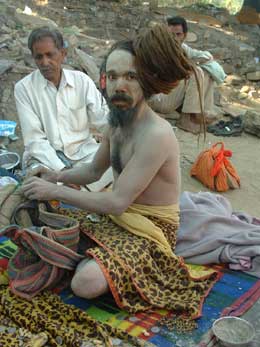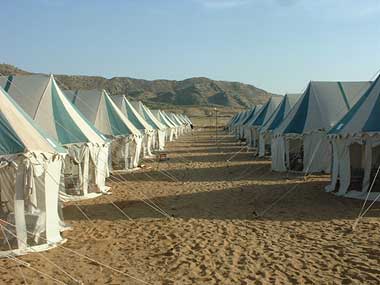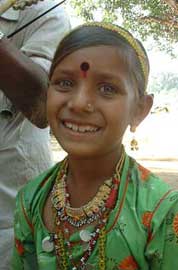Pushkar Snapshots
The Pushkar Fair was, well, different. It's partially a religious pilgrimage. Here's one of our fellow fair-goers.
There are a few similarities between the Pushkar Camel Festival and the Minnesota State Fair. In both, you will find animals displayed, showed, and sold. In Pushkar, camels are a center point, and may be adorned in many colors, following the Rajastani style of dress: colorful necklaces of yarn and beads, jingling anklets, and hennaed decorations covering their bodies. That is not to mention the saddle-wear! (Camels have many uses here - primarily as a form of transportation, especially pulling carts. The fair is a great location for buying and selling. One of the camels pulling our cart was a young camel, just purchased at the fair for Rs 11,000, about $225.) Then there are the horses. It appears that the young men that race them around may be the trainers - one young man wore a purple velour shirt, with a bandana around his head, and raced by us with a huge grin. We watched another "trainer" showing his stuff and the horse's, and it appeared that the owner was working to sell the horse to one of the group of apparent buyers watching as the young man trotted the horse around.
The Rajasthanis are well-known for their musical talents. Incidentally, these are everyday street clothes, not some guy dressing up for show.
As you can see, we need to do a bit of surmissing about what is actually transpiring in front of us. Reading between the lines. Unknown meanings with no translator. Perhaps that is part of the wonder of it all.
Another similarity with the Minnesota State Fair is the carnival - like the midway. Cotton candy. Much other street food - which we did not allow ourselves, except for some roasted peanuts. And complete with 4 ferris wheels, a few other rides, the freak show (ok, that is no longer PC in MN, but it continues here) - it seemed a major attraction at these shows were dancing girls who were really men in drag. (I was so not expecting men in drag that Hank had to explain to me later that that extremely ugly woman was really a man.) Imagine the movement of the colorful sari around jiggling hips, flashy jewelry.
The Pushkar Fair even has the hawker selling that new incredible device -- we could not quite make out the device he was selling, but he certainly had attracted a very interested crowd. It made me remember James watching the man selling the vegetable pealer at the MN State Fair this summer!
But then, there are differences. Like the crowds. Oh, now the MN State Fair has crowds, and the crowds might even compare on the days running up to the full moon. But on the day of the full moon, the Pushkar Fair is no longer just a Fair -- in fact, it never was just a fair -- it is a Pilgrimage that attracts a crowd unlike any I have ever experienced.
A bit of background first: Pushkar is one of the 5 holiest cities in the Hindu religion, and an important destination point for pilgrims, who come to bathe in the holy waters of the lake. There are 40 or 50 temples in this small town as well, and the only - or at least one of the only - temples to Brahma in all of India - so it is special. And the full moon in early November is the holiest of times here.
The town of Pushkar is fairly small, with narrow streets that do not allow traffic, at least during the festival (with the exception of some crazy motorcylists honking their way through the crowds). Following the narrow winding streets, you will eventually find the lake in the center of town. The lake is mostly surrounded on all sides by temples and ghats -- which are the steps that the pilgrims come down to bathe in the holy waters.
Some boys tend their goats in the desert. That's a temple at the peak of the hill.
Here is another point where we are a bit hazy. Maybe one of the readers of our website will be able to shed some light. Do you go to the temple first, or to the ghat, or does the order matter? If you are a pilgrim to Pushkar, do you visit many temples or just the one of your favorite god? And what were all the SHOES in front of the Brahma temple at the end of the major day of the pilgrimage? (the flip-flops were about 3 deep, left in the road, too many to simply have been lost in the crush of the morning crowd)
OK, let's try for the morning crowd. The day before we had wandered through the small streets, looking at the little shops that line the market, stopping to peek at the lake where there was space through the buildings. Now, the day of the full moon, we wanted to go to the ghats to watch the ritual of bathing. But the streets were packed, crowds jammed from one side of the street to the other. Our route led past the Brahma temple, but it was not possible to pass by; it was too crowded, and it turned out only Hindus were allowed past a certain point, with police stopping others and turning them around. So we continued through alternate pathways, finally to the lake. The crowds on the way back were even more intense, if that was possible!
The people who attend the festival are a broad cross section, but probably are mostly Rajastani villagers. We figured that perhaps less than 1% of the crowd was foreigners. For many of the villagers, it apparently is not common to see foreigners, and we often felt a bit like celebraties -- as we walked down the street, people say, "Hello," and come and shake our hand. Hand-shaking is not usual here, and I think they must learn that in school as the way westerners greet each other. For me, there was a special connection in particular with the women, who would catch my eye with their smiles, under their bright scarves. As we walked down the street on one of our evenings there, I felt a friendly brush on my elbow - I turned to see a smiling young woman, perhaps 18; I smiled, she touched my blond hair and my hat, and carried on, giggling with her friends. A few steps beyond, she turned and threw me one last smile.
Home sweet home in the desert. The black speck in the back is Glorian.
One our final evening, we returned to our camel cart to take us through the dunes back to our tent encampment. As we pulled away from the dunes where all the camels for the fair were resting, we could see the full moon rising above the ferris wheels, hear all the bells and the din of the crowds. The sounds gradually faded as we moved toward our encampment. Ah. Hank says I have been fully immersed in India, with these few days in Pushkar. I love it.
<Home
Another baba at the Fair.
You take a camel-cart to get out to the fairgrounds.
A young Rajasthani musician performed with her father at the Pushkar Fair.






